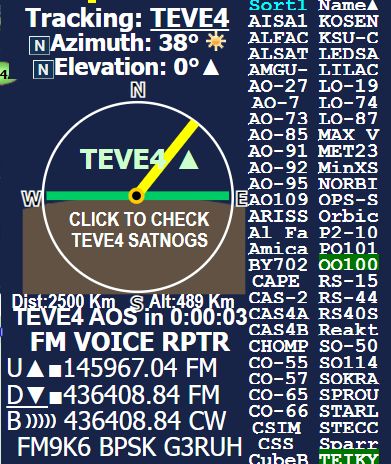How I use the Argentinian Amsat website for Doppler Tracking of Amateur Radio Satellites
How I use the Argentinian Amsat website for Doppler Tracking of Amateur Radio Satellites
Argentinian Amsat website gives live information on amateur radio satellite passes at: http://www.amsat.org.ar/pass.htm. The site was recommended to us by our LEO Satellite Repeater Contact WhatsApp group Elmer VU2AAP and I have also found it quite useful and use it regularly. This is the intial screenshot which comes up when you open the page.

You can see that the current passes are highlighted. There is also an audible alert. When the satellite is in range the picture of antenna pointing to the satellite appears. At other times, it is a compass dial. Satellite details are given on initial part which includes satellite name (e.g. ARISS for International Space Station), Date, Local pass timing, local maximum elevation in degrees and the Azimuth. If you hover the mouse on the satellite name, a picture of the satellite is also displayed (while viewing from desktop).
To begin with you have to set your grid or lattitude and longitude at the bottom of the page. Otherwise it will detect depending on the location of your internet service provider, which may be inaccurate.

If you click on the satellite name in the first column, the display above and below the compass dial will show you the details of the satellite. Otherwise the satellite with latest pass will be displayed. Display colour when the satellite is not in range is green background in the satellite list and orange below the compass dial. When the satellite is in range, display background in the list becomes yellow and that below the compass dial becomes white and there is an audible alert as well.

Tracking information shown above the compass face includes the satellite name, live Azimuth and Elevation. Compass needle changes colour and becomes active during the pass. Information displayed below the compass face includes the current distance from you, altitude of the satellite above the earth, and time into the pass. Here it is shown that TEVEL 4 has an FM voice repeater. Uplink and downlink frequencies are displayed live. Uplink frequency gradually moves up and downlink frequency gradually moves down. If a CTCSS tone is needed in the uplink, that will also be displayed. Beacon frequency and mode is also displayed.

I change the frequencies manually in my base station, looking at the live Doppler display on the webpage on my mobile phone, to the nearest step available in my radio, as soon as the change is more than half of the available step. For example, I have a minimum step of 5 kHz. So I change when it is 2.5 kHz off frequency. Alternatively you could program six to eight memory channels for the same and change the channel quickly. This is useful while operating using dual hand held radio from outdoors.